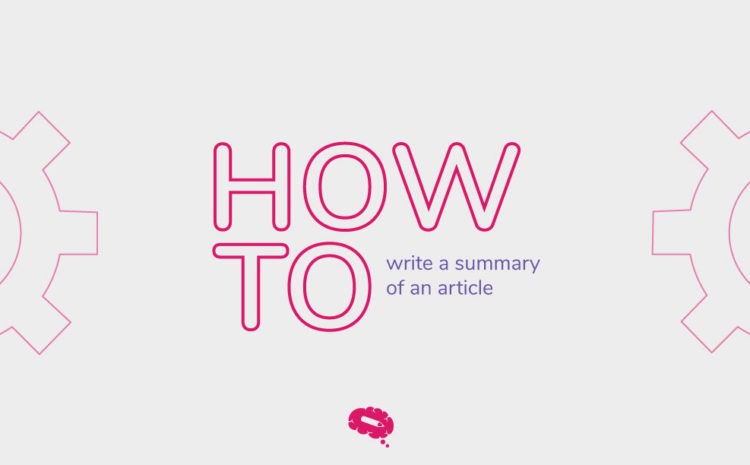When producing an article, a large amount of facts and information are incorporated into it, and frequently, this amount of material needs to be compressed to increase the article’s understandability.
In essence, a summary aids in determining whether an article meets the expectations regarding the issue, whether it was built with all the intricacies on the subject, whether it can lead to a conclusion, and so forth.
Although creating a summary of an article may seem simple and straightforward, it can be challenging to choose exactly what material is important enough to include. Additionally, there is much more to consider than simply restating the information.
But have no fear—in this post, you will discover detailed instructions on how to write a summary of an article correctly and effectively.
What is a summary and why is it important?
It’s vital to note that summaries are a powerful indicator of your reading and writing skills. A summary is simply a brief outline of an article’s main elements that are written entirely in your own words.
Generally speaking, a summary should be around one-third as long as the original and still must contain all of the most important information.
A summary has many benefits, and as was already mentioned, it’s important to condense a lot of the information in an article. This can be helpful for the writer because it aids in identifying the main points and key details, and it can provide a variety of perspectives that increase comprehension and shed light on the subject, besides communicating the essence of the article in an engaging way.
It can also make it simpler for readers to understand an article because they won’t have to wade through long paragraphs of text to figure out what your thesis statement was about.
Summaries vs. Reviews
Let’s discuss how to distinguish reviews from summaries before moving on to how to write a summary of an article.
A review typically refers to the expression of a viewpoint on the issue being discussed. It concentrates around the concepts of the narrative and how it was presented rather than the specific details.
A review also acknowledges the impact the topic has on someone or something. It can also be used to provide a thorough introduction to the topic, although, unlike summaries, reviews are not required to emphasize all of the major aspects of the topic in the same chronological order.
Reviews can be used for any topic that can be presented to an audience and are used in both formal and informal situations, such as “a movie review” or “a review of a research paper.”
A review’s quality might differ from one reviewer to the next based on how it is interpreted, as a good or a bad review. In contrast, summaries do not take into account any kind of opinion.
A summary is a succinct account of any representation or narrative that has been delivered and is used to aid in the reader’s comprehension of the material. It covers every critical point in the text and presents the substance in the same chronological order as the narrative.
A summary does not stray from the main aspects of the subject at all. It makes no mention of any evaluation of the subject or the writer’s ideas. Summaries always follow the same format as the subject they are summarizing, beginning with the introduction and ending at the subject’s conclusion. Although summaries are frequently employed in academic settings, it can be applied to any other type of story.
Steps for Writing an Effective Summary
The first step in learning how to write a summary of an article is to understand that article summaries need to show that you can read and interpret information.
1. Read the article at least twice
To grasp the arguments and the article’s topic, you should first read the article thoroughly. At this stage, don’t bother about taking notes; instead, just concentrate on reading the article. This is where having strong reading abilities come in.
2. State the main idea
You will be able to identify the article’s core theme and topic after carefully reading the article.
3. Start taking notes
After identifying the main topic, start to take note of the supporting arguments, concentrate on the key points and consider what else is in the article that might be useful or important for the summary.
Additionally, it’s a good idea to highlight specific words or phrases in the content and when summarizing the article, incorporate the main keywords.
4. Write it down
Start writing it down using your own words and avoid copying phrases and sentences from the article unless they’re direct quotations.
5. Think about the structure
A summary must have an introduction, body paragraphs, and a conclusion that are no longer than one-third the article’s length.
- Introduction:
Your opening paragraph should contain a hook that draws the reader in. The introduction includes a general description of the topic, the article’s title, and, ideally, a thesis statement that captures the essence of the text and that explains which points you’re going to expand on.
- Body Paragraphs:
Each supporting argument should have its own body paragraph. Talk about it, clarify, or condense those supporting points in each body paragraph. Be sure to talk about the reasoning behind each individual conclusion and the supporting evidence they employed.
- Conclusion:
Restate your introduction’s topic sentence or thesis statement about the key argument to start your conclusion, make sure you rephrase this from your opening statement.
You can better communicate the article’s overall meaning and arguments by using this section. Describe any additional issues, consequences, or problems that the article raises in a few phrases.
Communicate science visually with the power of infographics
Start utilizing the Mind The Graph tool and gain access to excellent infographic templates to make articles more visually appealing to readers.

Subscribe to our newsletter
Exclusive high quality content about effective visual
communication in science.





